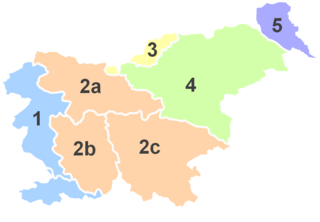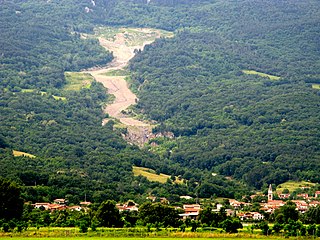Protected areas of Slovenia include one national park, three regional parks, several natural parks, and hundreds of natural monuments and monuments of designed nature. They cover about 12.5% of the Slovenian territory. Under the Wild Birds Directive, 26 sites totalling roughly 25% of the nation's land are "Special Protected Areas"; the Natura 2000 proposal would increase the totals to 260 sites and 32% of national territory.

Ajdovščina is a small town with a population of about 6,700, located in the Vipava Valley, Slovenia. It is the administrative centre of the Municipality of Ajdovščina.

The Dinaric Alps, also commonly Dinarides, are a mountain range in Southern and Southeastern Europe, separating the continental Balkan Peninsula from the Adriatic Sea. They stretch from Italy in the northwest through Slovenia, Croatia, Bosnia and Herzegovina, Serbia, Montenegro, Kosovo to Albania in the southeast.

Orjen is transboundary Dinaric Mediterranean limestone mountain range, located between southernmost Bosnia and Herzegovina and southwestern Montenegro.

The Slovene Littoral is one of the five traditional regions of Slovenia. Its name recalls the former Austrian Littoral, the Habsburg possessions on the upper Adriatic coast, which the Slovene Littoral was part of.
The Banjšice Plateau is a karst plateau in western Slovenia, in the traditional region of Goriška. It is a dispersely settled area, distinguished by its history and biodiversity. Geographically, it belongs to the Dinaric Alps.

The Vipava Valley is a valley in the Slovenian Littoral, roughly between the village of Podnanos to the east and the border with Italy to the west. The main towns are Ajdovščina and Vipava.

Otlica is a dispersed settlement in the hills north of Ajdovščina in the Littoral region of Slovenia. It is made up of smaller clusters of the hamlets of Sibirija, Kitajska, Kurja Vas, and Cerkovna, as well as a number of outlying isolated farms. Together with the ridge-top villages of Predmeja, Kovk, and Gozd, it is part of an area locally known as Gora.

Predmeja is a settlement in the Municipality of Ajdovščina in the Littoral region of Slovenia. It lies on the edge of a karst plateau north of the town of Ajdovščina, overlooking the Vipava Valley. Together with the ridge-top villages of Otlica, Kovk, and Gozd, it is part of an area locally known as Gora.

Snežnik is a wide karst limestone plateau with an area of about 85 km2 (33 sq mi) in the Dinaric Alps of Slovenia. It mainly consists of Cretaceous limestone, with Jurassic limestone and a small amount of dolomite at the top. The surface was transformed by ice in the last glacial period. It is generally level, but has numerous dry valleys, sinkholes, about 300 caves and shafts, and cold-air pools with temperatures reaching −32 °C (−26 °F) in the coldest part of year. The surface is mainly stony, covered with patchy and shallow soil, except for the larger depressions. Because the plateau is only 28 km (17 mi) from the Adriatic Sea, it has up to 3,000 millimetres (120 in) of precipitation per year. It is covered by snow in winter. Due to the karst nature of the plateau, there are no surface streams.

The Slano Blato Landslide, or the Salt Mud Slide, is a periodic landslide in Slovenia that is triggered approximately once a century. Although around 8,000 active landslides are present in Slovenia, the Slano Blato Landslide stands out as one of the most serious in terms of the damage it has caused.

The Municipality of Mirna Peč is a municipality in southeast Slovenia, located in the traditional region of Lower Carniola. The seat of the municipality, which was established in 1998, is Mirna Peč. With an estimated population of 2,800, the municipality is included in the Southeast Slovenia Statistical Region.
The Rovte Hills are a group of hills in western Slovenia.

The Lož Karst Field, also known as the Lož Valley, is a karst field in Inner Carniola in southwest Slovenia. It is the smallest karst field in Inner Carniola.

The Račna Karst Field is a karst field in the northern edge of the Lower Carniolan karst area, south of Grosuplje, Slovenia. It has rich natural and cultural value. Because of its ecological significance, it is anticipated that a nature park will be established there and that it will be included in the Natura 2000 program.

The Udin Woods is one of the oldest glacial terraces in the Ljubljana Basin. It is a contiguous wooded area clearly delineated from its surroundings. The woods is dominated by Scots pine, and deciduous trees include sessile oak, hornbeam, and beech. It has natural value in terms of its botanical features, terrain, and geomorphology. It was given the status of a protected landscape area in 1985.

The Bloke Plateau is an extensive bowl-like plateau in southwest Slovenia, part of the traditional region of Inner Carniola.

The Rute Plateau is a karst limestone plateau in Lower Carniola, Slovenia with an area of about 9 square kilometers (3.5 sq mi).

The Karst Living Museum is a nature trail in Slovenia. Part of the Karst Plateau, the museum is an ecologically-important area with many karst features. It was recognized as Slovenia's best thematic trail in 2017, and the region is a Natura 2000 site.

















